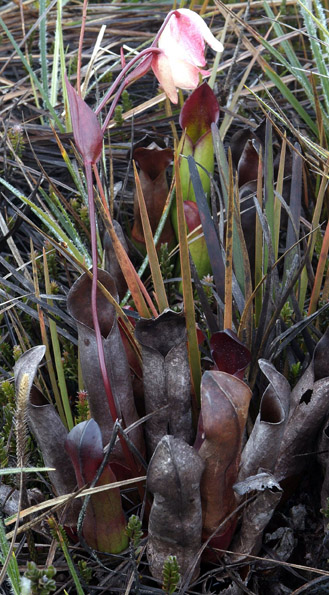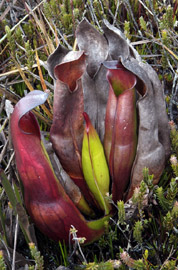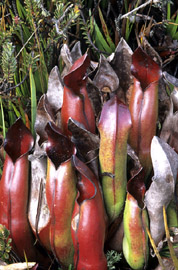|
Carnivorous Plant Newsletter
Volume 34, Number 1, March 2005, pages 4 - 6; Front Cover
Heliamphora sarracenioides, a New Species of
Heliamphora (Sarraceniaceae) from Venezuela
Thomas Carow • Münnerstadt • Germany
Andreas Wistuba • Mannheim • Germany
Peter Harbarth • Dossenheim • Germany
Keywords: new taxa: Heliamphora sarracenioides, Venezuela.
Received: 9 March 2004
Introduction
During our last expedition to some of the table mountains in Venezuela in January 2004 we discovered a species of Heliamphora (Sarraceniaceae) that has unique characteristics (see Front Cover, and Figures 1-4), and hence is described as a new species here.
Heliamphora sarracenioides Carow, Wistuba & Harbarth spec. nov.
Caudex ramosus; foliis rosulatis; amphoris 20-30 cm longis, tubulosis, basin versus infundibuliformibus, in parte media ventricosis, et in parte superiore obconicis, ore versus angustatis extus glabris, parte superiore interiore glabris; appendicibus triangularibus, 2.5-3.5 cm latis, 4-5 cm longis, basi non constrictis.
Inflorescentiis 2-3-floris, racemosis, ad 60 cm longis; flores nutantes; pedicellis 5 cm longis; petalis 4 oblongo-lanceolatis, albidis vel pallide-roseis, 4-4.5 cm longis; staminibus 10, 1-serialibus, filamentis 5-6 mm longis; antheris oblongo-lanceolatis, 7-8 mm longis; ovario valde tomentoso; stylo glabro; stigmate 3 lobato; seminibus fuscis, oblongis, ca. 1.5 mm longis, testa conspicue membranaceo-alata.
Rhizomes branching. Pitchers infundibulate in the lower half, ventricose in the middle and conical in the upper third, slightly narrowing towards the mouth; pitchers 20 to 30 cm long, 3-5 cm wide in the middle; upper part of the pitchers 2.5-3.5 cm wide; the uppermost quarter of the pitcher completely hairless but with scattered glands on the inner side. Underneath this zone the hairy zone starts abruptly. Lid emerging directly from the back of the pitcher mouth without any constriction, 3-4 cm wide and 4-5 cm long, often exceeding the pitcher mouth in width, triangular, upright, ending with a tip that is bent back slightly; sometimes the lids are bent forwards, overarching the mouth of the pitcher; the inner side of the lid fairly evenly scattered with glands, up to 0.2 mm across. Most plants have pitchers that are colored almost entirely red, however plants with greenish pitchers, some veined deeply red, were found as well. Inflorescence up to 60 cm long, with 2-3 flowers, peduncle entirely glabrous, pedicels 5 cm long. All carry bracts, the lowest often is transformed into a rudimentary pitcher. Tepals lanceolate, 4-4.5 cm long, 1.7-2,2 cm wide, white to whitish-pink; approximately 10 stamens in 1 series, filaments 5-6 mm long, anthers oblong lanceolate, 7-8 mm long, 1.5 mm wide; ovary 3 celled, pubescent, style glabrous; seed approximately 1.5 mm long, compressed, ovate, irregularly winged.
Specimens examined
Heliamphora sarracenioides: South Venezuela, Gran Sabana, Estado Bolivar; Wistuba, Carow & Harbarth No. 01/04/s1, holotype, flowering plant (VEN). This specimen we prepared shows a plant typical of the population that we observed.
Distribution
Heliamphora sarracenioides was discovered on a Venezuelan table mountain of the northern part of Gran Sabana. The population we found is healthy, and consists of many plants. (We observed approximately 200 individual plants, but did not attempt to make an accurate assessment of the total plant population.) Since the population is apparently restricted to a fairly small and isolated area, we believe that it is fairly vulnerable. For reasons of conservation we decided not to present exact data on the location, or disclose what other Heliamphora species are found in the immediate area of Heliamphora sarracenioides.
Related species
The structure of the flowers with comparably large anthers in one series implicates a close relationship to Heliamphora heterodoxa and Heliamphora folliculata. The structure of the pitcher however, with a glabrous zone beneath the rim, separates it well from H. heterodoxa which has a more infundibulate pitcher mouth and an upper zone with a hairy inner side of the pitcher wall. Both the evenly distributed, relatively large glands in the lid, and the shape of this lid itself clearly separates H. sarracenioides from both Heliamphora heterodoxa and H. folliculata.
Etymology
The pitchers reminded us of Sarracenia pitchers. Therefore we decided to name it Heliamphora sarracenioides.
Discussion
The question arises instantly, how the lid of H. sarracenioides could have evolved. The pitcher mouth of Heliamphora sarracenioides has an extremely broad lid that is often wider than the pitcher mouth itself; this bears little similarity to the pitcher mouth and lid of any other species in the genus (Maguire, 1978; Steyermark, 1984, 1986; Nerz & Wistuba, 2001; Wistuba et al., 2001; Wistuba et al., 2002). The lids of most other species emerge from a contracted base or are highly reduced while in Heliamphora sarracenioides it directly protrudes from the back of the pitcher. It is not yet clear how the unique lid structure of Heliamphora sarracenioides is related morphogenetically to the lids of other species. As published previously (Wistuba et al., 2001; Wistuba et al., 2002), we base our interpretations of Heliamphora systematics on the structure and shape of the gland bearing pitcher appendage (=lid) as one of the most valuable characteristics in Heliamphora systematics.
All other known Heliamphora species show an interesting dimorphism. Up to a certain age “juvenile” pitchers are produced that show little similarity to the characteristic traps of older and adult plants. The juvenile pitchers of all Heliamphora are generally similar, and are in fact strikingly similar to the pitchers of adult H. sarracenioides plants, both in shape and the glabrous inner wall of the upper pitcher areas. While it is too early to present any definitive conclusions here, we believe that the pitchers of Heliamphora sarracenioides could in fact represent slightly modified gigantic “juvenile” pitchers, and that Heliamphora sarracenioides could at least partly have abandoned the dimorphism visible in all other known species of Heliamophora. It also seems possible that H. sarracenioides represents a very old type of Heliamphora that does not yet show the typical dimorphism of the other species known so far. We cannot, however, rule out, that the unique pitcher shape might be the result of a special adaptation during the evolution of H. sarracenioides.
Literature
Maguire, B. 1978. Sarraceniaceae (Heliamphora), in: The Botany of the Guyana Highland Part-X, Memoirs of the New York Botanical Garden, 29: 36-61.
Nerz, J. and Wistuba, A. 2000. Heliamphora hispida (Sarraceniaceae), a New Species from Cerro Neblina, Brazil-Venezuela. Carniv. Pl. Newslett. 29: 37-41.
Steyermark, J.A. 1984. Venezuelan Guyana, Annals of the Missouri Botanical Garden, 71: 302-312.
Steyermark, J.A. 1986. Expedition to the Lost World. Annals of the Missouri Botanical Garden 74(7): 5-7.
Wistuba, A., Harbarth, P., and Carow, T. 2001. Heliamphora folliculata, a New Species of Heliamphora (Sarraceniaceae) from the ‘Los Testigos’ Table Mountains in the South of Venezuela. Carniv. Pl. Newslett. 30:120-125.
Wistuba, A., Carow, T., and Harbarth, P. 2002. Heliamphora chimantensis, a New Species of Heliamphora (Sarraceniaceae) from the ‘Macizo de Chimanta’ in the South of Venezuela. Carniv. Pl. Newslett. 31:78-82.

Front Cover: Heliamphora sarracenioides. Photograph by Andreas Wistuba.

Figure 1: Heliamphora sarracenioides plant. Photograph by Andreas Wistuba.

Figure 2: Heliamphora sarracenioides plant. Photograph by Andreas Wistuba.

Figure 3: Heliamphora sarracenioides plant. Photograph by Thomas Carow.

Figure 4: Heliamphora sarracenioides pitcher opening. Photograph by Andreas Wistuba.
|

